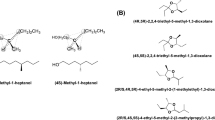Abstract
The host-seeking behavior of hematophagous arthropods can be altered by symbiotes, thereby biasing sampling techniques and inaccurately reflecting symbiote or vector prevalence. Knowledge of any altered vector behavior is essential in vector control and monitoring. Species of Chrysops are vectors of human and animal pathogens. Six species of Chrysops were collected at two locations in South Carolina to determine if diurnal host-seeking behavior was influenced by trypanosomatid infection. Fifty-five percent of the host-seeking Chrysops were infected with trypanosomatid parasites. Prevalence of infection in host-seeking Chrysops were statistically indistinguishable during both the morning and evening at both sites. The results indicate that the prevalence of parasites among wild host-seeking Chrysops might not be influenced by infection status.
Similar content being viewed by others
REFERENCES
Anez, N., and East, J. S. (1984). Studies on Trypanosoma rangeli Tejera, (1920). II. Its effect on feeding behavior of triatomine bugs. Acta Trop. 41: 93–95.
Aksoy, S. (1999). Establishment and maintenance of small scale tsetse colonies. In Maramorosch, K., and Mahmood, F. (eds.), Maintenance of Human, Animal, and Plant Pathogen Vectors, Science Publishers, Enfield, New Hampshire, pp. 127–136.
Bowen, M. F., Davis, E. E., Haggart, D., and Romo, J. (1994). Host-seeking behavior in the autogenous mosquito Aedes atropalpus. J. Insect Physiol. 40: 511–517.
Chvala, M., Lyneborg, L., and Moucha, J. (1972). The Horse Flies of Europe (Diptera, Tabanidae), Entomological Society of Copenhagen, Copenhagen, 500 pp.
Durvasula, R. V., and Taneja, J. (1999). Maintenance of the triatomine bugs Rhodnius prolixus and Triatoma dimidiata under laboratory conditions. In Maramorosch, K., and Mahmood, F. (eds.), Maintenance of Human, Animal, and Plant Pathogen Vectors, Science Publishers, Enfield, New Hampshire, pp. 139–157.
Ebbert, M. A., Burkholder, J. J., and Marlowe, J. L. (2001). Trypanosomatid prevalence and host habitat choice in woodland Drosophila. J. Invertebr. Pathol. 77: 27–32.
Gray, E. W., Adler, P. H., and Noblet, R. (1996). Economic impact of black flies (Diptera: Simuliidae) in South Carolina and development of a localized suppression program. J. Am. Mosq. Control Assoc. 12: 676–678.
Hoare, C. A. (1972). The Trypanosomes of Mammals. Blackwell Scientific Publications, Oxford. 749 pp.
Jenni, L., Molyneux, D. H., Livesey, J. L., and Galun, R. (1980). Feeding behavior of tsetse flies infected with salivarian trypanosomes. Nature 283: 383–385.
Krinsky, W. L. (1975). Trypanosomes from white-tailed deer (Odocoileus virginianus) in New York. J. Parasitol. 61: 145–146.
Krinsky, W. L., and Pechuman, L. L. (1975). Trypanosomes in horse flies and deer flies in central New York state. J. Parasitol. 61: 12–16.
Mansfield, J. M. (1977). Nonpathogenic trypanosomes of mammals. In Kreier, J. P. (ed.), Parasitic Protozoa Vol. 1 Taxonomy, Kinetoplastids, and Flagellates of Fish, Academic Press, New York, pp. 297–327.
Maslov, D. A., Podlipaev, S. A., and Lukes, J. (2001). Phylogeny of the Kinetoplastida: Taxonomic problems and insights into the evolution of parasitism. Memórias do Instituto Oswaldo Cruz 96: 397–402.
Moore, J. (2002). Parasites and the Behavior of Animals, Oxford Press, Oxford, 315 pp.
Wallace, F. G. (1962). The Trypanosomatidae parasites of horseflies with the description of Crithidia rileyi n. sp. J. Protozool. 9: 53–58.
ACKNOWLEDGMENTS
I wish to thank P.H. Adler, J.C. Morse, A.G. Wheeler, and E. Ruppert for reviewing drafts of this manuscript and J. Burger for verifying identifications of Chrysops spp. This research was partially supported by an W.C. Nettles Memorial Grant, Clemson University.
Author information
Authors and Affiliations
Corresponding author
Rights and permissions
About this article
Cite this article
Reeves, W.K. Host-Seeking Behavior of Selected Chrysops Species (Diptera: Tabanidae) Harboring Trypanosomatidae (Kinetoplastida). J Insect Behav 19, 93–97 (2006). https://doi.org/10.1007/s10905-005-9002-3
Revised:
Accepted:
Published:
Issue Date:
DOI: https://doi.org/10.1007/s10905-005-9002-3




